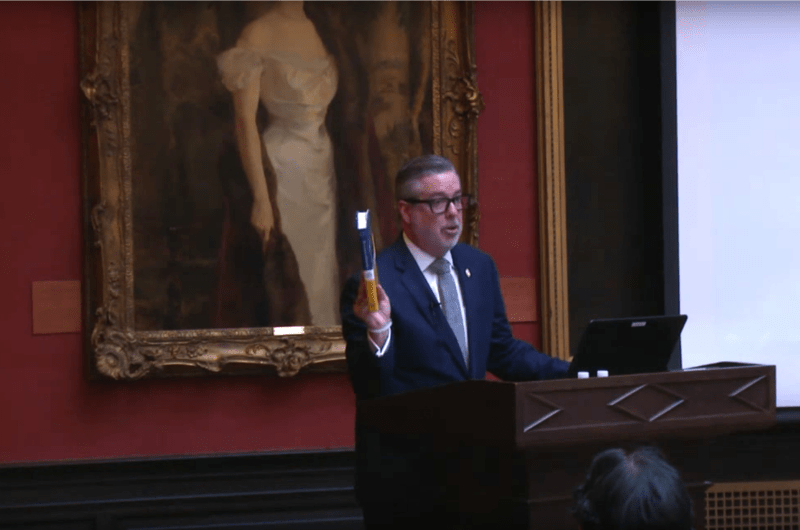Drexel's History Is Alive in the Present, President John A. Fry Says at Lecture
 By Ben Seal
By Ben Seal

President John A. Fry speaks at a Dec. 1 lecture.
Where is Drexel University headed in the next 25 years? What will its campus and community look like and how will its academic principles and civic mission meet the rapidly changing world? To find answers, we must keep one eye trained on the 125 years of history gathered in the University’s past, President John A. Fry said Dec. 1 at a lecture as part of a series looking at the varied chapters of that history.
The University sits in a “Janus-like moment,” Fry said, referring to the Roman god often depicted facing in two directions at once. Drexel is glancing forward to opportunities still to come while drawing inspiration and insight from the challenges and successes of the past, he said. Citing Kierkegaard’s maxim that life can only be understood backward but must be lived forward, he said appreciating Drexel’s past will help frame its future.
Beginning with its practical, accessible location, the University was designed “to face the real world.” By following the directives founder Anthony Drexel gave all those years ago — to show students where the world was headed, to prepare them to lead society’s efforts and meet its biggest challenges, and to build a resilient community — the University has remained aligned with its history, he said. The creation of Drexel itself was representative of the ideas still guiding the institution today.
“If you don’t see what you need, you don’t lament it,” said Fry. “You build it, you create it, you make it happen.”
With that in mind, Fry spoke of the ways Drexel will build on its past as it moves forward. In many respects, the Schuylkill Yards project that will develop the 10-acre site next to Drexel’s main campus and adjacent to Amtrak’s 30th Street Station and Brandywine’s Cira Centre is emblematic of where the University will turn next. It will be one of the most significant acts of creation the school has ever undertaken. Predicting the academic future is a challenge, he said, but Drexel can ensure that it has anticipated “the need for place” so students can continue to learn and grow. The expansion and redesign of Drexel’s campus and the area surrounding it are an essential part of that process.
On the academic side, Drexel’s future is sure to focus on experiential learning and research. Fry pointed to the University’s continued rise up the ranks of the nation’s top research universities and the growing number of patents the school produces each year — all of which contribute to the mission to “save lives, to help people live better and to grow the economy.”
Civic engagement has been a focus for Fry since joining Drexel, and will be one way the University maintains continuity amid change, he said. With the Lindy Center for Civic Engagement, the Dornsife Center for Neighborhood Partnerships and the new Dragon Volunteers program, Fry said “we are on our way to developing into an institution that can truly call itself one day the most civically engaged university in the United States.”
In the process of looking forward to the next 25 years of Drexel’s history, the University has made a number of bets on the future that will help shape the institution, Fry said. Among them are the A.J. Drexel Nanomaterials Institute, the A.J. Drexel Autism Institute, the school’s growing global engagement in public health and its development of smart fabrics, he said. According to Fry, those areas of Drexel are all examples of the values instilled by the University’s founder and they will all be part of the shifting landscape of the coming decades.
Fry expressed admiration for A.J. Drexel’s ability to “see around so many corners” when he created the University and established in his deeds and values a template for its place in an uncertain future. It’s interesting to look at what the University is doing now and relate it to what its founder might himself have been doing in the modern age, Fry said. The connections are often clear.
“I’ve been involved with a lot of institutions over the years,” said Fry, “and I’ve never seen one whose history was so alive in the present.”
Drexel News is produced by
University Marketing and Communications.
